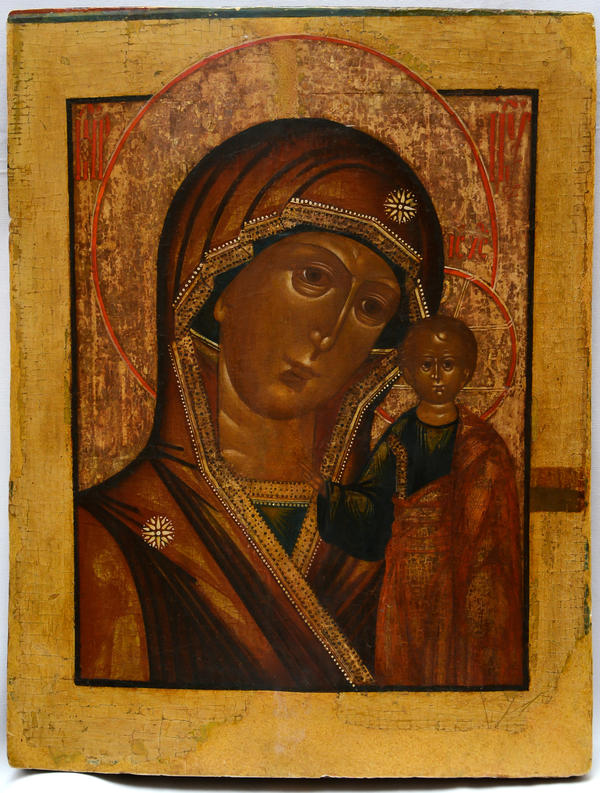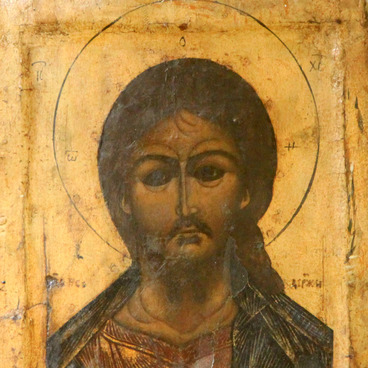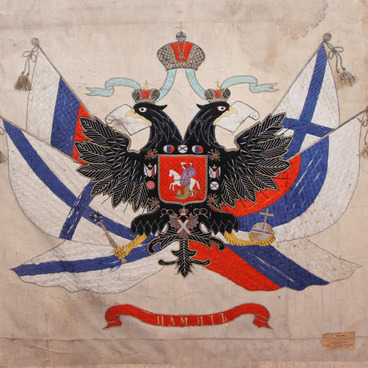Our Lady of Kazan was transferred to the Museum of Local History of the Republic of Mordovia in 2000. Before that, the icon was in the Museum of National Folk Architecture and Rural Life located in the village of Makarovka to where it had been delivered in 1970 from an expedition across the Republic of Mordovia. There is no information about the origin of the icon but it is known that this masterpiece belongs to mid – second part of the 19th century. Its painters were most likely painters of Moscow or Moscow Region Old Believer icon workshop. Some special features prove it.
The icon was originally painted on the background of silver leaf. The background as well as halos looked as gold due to yellow varnish cover. The lack of an ark, a deepening in the center of the icon panel, partially proves that the icon was painted by the Popovtsy, priested Old Believers. As a rule, the Bezpopovtsy, priestless Old Believers, did not use icons without arks.
In general, the icon was painted in accordance with traditional canons of old Russian iconography. Its general style of performance is typical of similar works of the 17th century. Layers of light ochre are traditionally put on dark underpainting. Great attention is paid to faces, they are vivid and expressive. Our Lady is reflective and sad though dignified and calm. The Christ Child is looking calmly and graciously from the icon as well.
An original opush, a thin line on the edges of the icon, is almost completely lost and remained only on the upper and left parts of the panel. The icon has been renewed many times since its creation, including lost fragments tinted and frames repainted. The present renewal returned original gold color to the frames.
When the icon was delivered to the museum, some traces of cloth covering its back side were detected. On its low part there was a wooden handle fixed with forged nails. Such details prove that the image was used as processional.
Our Lade of Kazan is one of the most revered icons in Russia. Its recovery dated back to July 8, 1579. According to legends, the image was recovered in Kazan with the help of Matrona, a 9-year-old girl. The Virgin appeared to the girl in her dreams three times pointing at a burnt house. After Matron having told priest Yermolay about her dream, the icon was discovered in this place.
Later the icon was closely connected with important historical events. In late 16th-early 17th centuries, the Time of Troubles, the Poles came to Russia and occupied Moscow. At that time, Patriarch Hermogenes was the spiritual leader of the Russian opposition. With his blessing the recovered image of Our Lady was delivered from Kazan and became the main icon of the volunteer army.
In the first month of spring of 1612 the Russian Volunteer Army headed by Kuzma Minin, a citizen of Nizny Novgorod, and Prince Dmitry Pozharsky set out for Moscow. Our Lady of Kazan accompanied them in this campaign and inspired the Orthodox army to liberate Russia from invaders of different faith. In the winter of this year the capital was liberated from the Polish troops.
Following the order of Tsar Michael Fyodorovich Romanov and with the blessing of Patriarch Filaret, a special holy day was established to commemorate the liberation of Moscow. Every year on October 22 (November 4, New style) the image of Our Lady of Kazan was to be honored with a procession of the cross. In Kazan celebration on the recovery of the icon was held on July 21 new style. Following the order of Tsar Alexey Mikhailovich these regional feast days became national holidays in 1649.
The icon was originally painted on the background of silver leaf. The background as well as halos looked as gold due to yellow varnish cover. The lack of an ark, a deepening in the center of the icon panel, partially proves that the icon was painted by the Popovtsy, priested Old Believers. As a rule, the Bezpopovtsy, priestless Old Believers, did not use icons without arks.
In general, the icon was painted in accordance with traditional canons of old Russian iconography. Its general style of performance is typical of similar works of the 17th century. Layers of light ochre are traditionally put on dark underpainting. Great attention is paid to faces, they are vivid and expressive. Our Lady is reflective and sad though dignified and calm. The Christ Child is looking calmly and graciously from the icon as well.
An original opush, a thin line on the edges of the icon, is almost completely lost and remained only on the upper and left parts of the panel. The icon has been renewed many times since its creation, including lost fragments tinted and frames repainted. The present renewal returned original gold color to the frames.
When the icon was delivered to the museum, some traces of cloth covering its back side were detected. On its low part there was a wooden handle fixed with forged nails. Such details prove that the image was used as processional.
Our Lade of Kazan is one of the most revered icons in Russia. Its recovery dated back to July 8, 1579. According to legends, the image was recovered in Kazan with the help of Matrona, a 9-year-old girl. The Virgin appeared to the girl in her dreams three times pointing at a burnt house. After Matron having told priest Yermolay about her dream, the icon was discovered in this place.
Later the icon was closely connected with important historical events. In late 16th-early 17th centuries, the Time of Troubles, the Poles came to Russia and occupied Moscow. At that time, Patriarch Hermogenes was the spiritual leader of the Russian opposition. With his blessing the recovered image of Our Lady was delivered from Kazan and became the main icon of the volunteer army.
In the first month of spring of 1612 the Russian Volunteer Army headed by Kuzma Minin, a citizen of Nizny Novgorod, and Prince Dmitry Pozharsky set out for Moscow. Our Lady of Kazan accompanied them in this campaign and inspired the Orthodox army to liberate Russia from invaders of different faith. In the winter of this year the capital was liberated from the Polish troops.
Following the order of Tsar Michael Fyodorovich Romanov and with the blessing of Patriarch Filaret, a special holy day was established to commemorate the liberation of Moscow. Every year on October 22 (November 4, New style) the image of Our Lady of Kazan was to be honored with a procession of the cross. In Kazan celebration on the recovery of the icon was held on July 21 new style. Following the order of Tsar Alexey Mikhailovich these regional feast days became national holidays in 1649.



